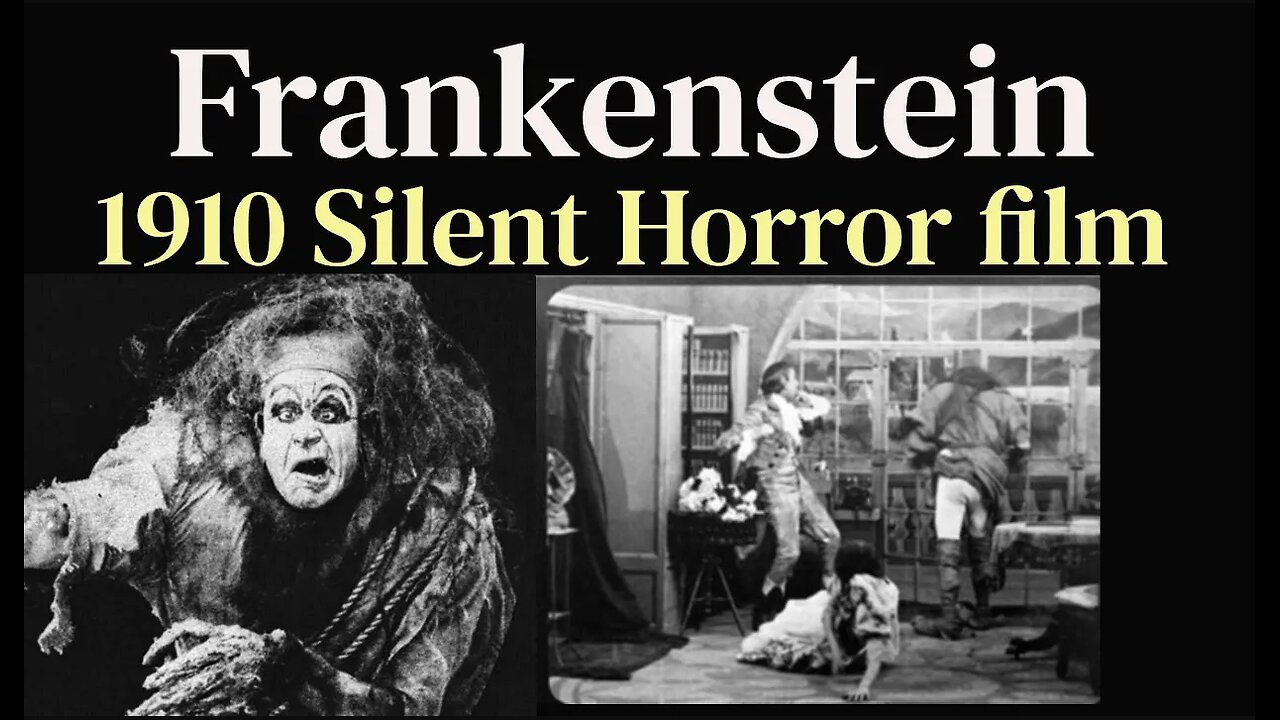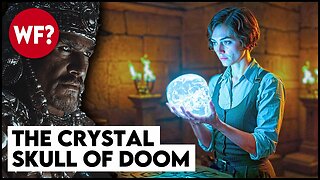Premium Only Content

Frankenstein (1910 American Short Silent Horror film)
Produced by Edison Studios. It was directed by J. Searle Dawley, who also wrote the one-reeler's screenplay, broadly basing his "scenario" on Mary Shelley's 1818 novel Frankenstein: or The Modern Prometheus. This short motion picture is generally recognized by film historians as the first screen adaptation of Shelley's work. The small cast, who are not credited in the surviving 1910 print of the film, includes Augustus Phillips as Dr. Frankenstein, Charles Ogle as Frankenstein's monster, and Mary Fuller as the doctor's fiancée.
Plot
Described as "a liberal adaptation of Mrs. Shelley's famous story", the film shows young Frankenstein (his first name in the book, Victor, is never mentioned) discovering the "mystery of life" after two years at university. He gives life to a creature built by mixing different chemicals, and the monster follows Frankenstein back to his parents' house. The conclusion, completely different from Mary Shelley's book, shows the creature disappearing after seeing its own reflection in the mirror, and without killing Victor's younger brother or his fiancée Elizabeth, as happened in the novel.
Cast
Mary Fuller as Elizabeth
Charles Stanton Ogle as The Monster
Augustus Phillips as Frankenstein
Production
Frankenstein was filmed here, at Edison Studios in the Bronx, N.Y.
J. Searle Dawley, working in his third year for Edison Studios, shot the film in three days at the company's Bronx facilities in New York City on January 13, 15 and 17, 1910. Staff writers for the Edison Kinetogram assured theatergoers in 1910 that the company's film adaptation was deliberately designed to de-emphasize the horrific aspects of Shelley's story and to focus instead on the tale's "mystic and psychological" elements.
Reception
Newspapers and magazines of the time, such as New York newspapers The Film Index and The Moving Picture World, highlighted the monster creation scene as "the most remarkable ever committed to a film".[6] After the film's official premiere, on April 9, The Moving Picture World published a negative review signed by W. Stephen Bush, probably one of the first critics to worry about what could be shown in films:
I have the sincerest admiration for the Edison and Vitagraph studios, but it must be said, with all due deference to these distinguished producers, that such films as ‘Frankenstein’ and ‘The Mistery of Temple Court’, while delightful literature to coroners, undertakers, gravediggers, and morgue-keepers, fail to please the general public. ‘Fail to please’ is putting it mildly. (…) Death scenes and executions are interesting historical reading, when well described, but a portrayal of these things on a living screen may well be dispensed with.
Rediscovery and preservation
For many years, it was believed a lost film. In 1963, a plot description and stills (below) were discovered published from the March 15, 1910, issue of the film catalog The Edison Kinetogram. For many years, these images were the only widely available visual record of the Charles Ogle version of the monster.
In the early 1950s, a print of this film was purchased by a Wisconsin film collector, Alois F. Dettlaff, from his mother-in-law, who also collected films. He did not realize its rarity until many years later. Its existence was first revealed in the mid-1970s. Although somewhat deteriorated, the film was in viewable condition, complete with titles and tints as seen in 1910. Dettlaff had a 35 mm preservation copy made in the late 1970s. He also issued a DVD release of 1,000 copies.
BearManor Media released the public domain film in a restored edition on March 18, 2010, alongside the novel Edison's Frankenstein, which was written by Frederick C. Wiebel, Jr.
In 2016, the film society of the University of Geneva undertook their own restoration of the film, with image restoration by Julien Dumoulin and an original soundtrack by Nicolas Hafner, performed on a Wurlitzer theatre organ located at College Claparède. The restored version of the film was shown on 10 October 2016.
-
 0:50
0:50
Sean Unpaved
11 hours ago $4.08 earnedWelcome “Unpaved w/ Sean Salisbury” to Rumble
24.2K3 -
 2:10:09
2:10:09
FreshandFit
5 hours agoKicking Out Old Annoying Hoes In Las Vegas!
47.7K56 -
 25:53
25:53
Stephen Gardner
7 hours ago🔥BREAKING: Trump HATING LAWYER busted in $17 million money laundering scheme!
29.6K101 -
 20:10
20:10
CartierFamily
14 hours agoAndrew Schulz DESTROYS Charlamagne’s WOKE Meltdown on DOGE & Elon Musk!
110K97 -
 33:56
33:56
The Why Files
9 days agoLegend of the 13 Crystal Skulls | From Mars to the Maya
65.1K39 -
 2:56:14
2:56:14
TimcastIRL
7 hours agoEPSTEIN Files DROP, FBI GOES ROGUE, AG Says They COVERED UP Epstein Case w/Amber Duke | Timcast IRL
183K98 -
 1:39:23
1:39:23
Kim Iversen
8 hours ago"Canada's Trump" Is Trudeau’s Worst Nightmare: Is Maxime Bernier the Future of Canada?
75.8K75 -
 DVR
DVR
Bannons War Room
10 days agoWarRoom Live
2.67M446 -
 16:06
16:06
The Rubin Report
14 hours agoProof the Islamist Threat in England Can No Longer Be Ignored | Winston Marshall
91.1K82 -
 2:07:07
2:07:07
Robert Gouveia
11 hours agoFBI Files Coverup! Bondi FURIOUS; SCOTUS Stops Judge; Special Counsel; FBI Does
116K87